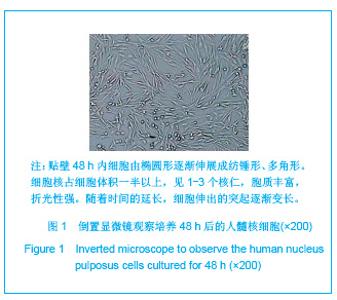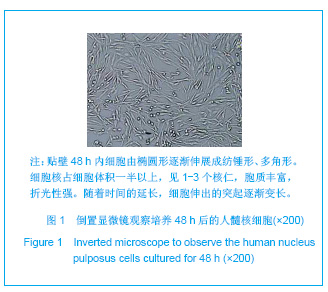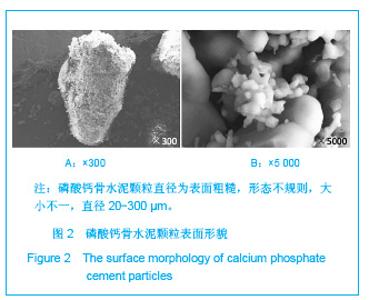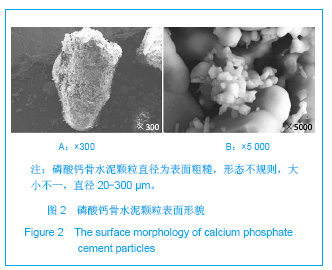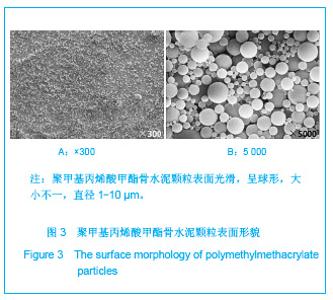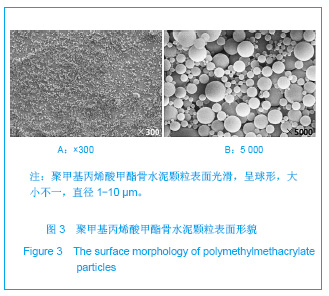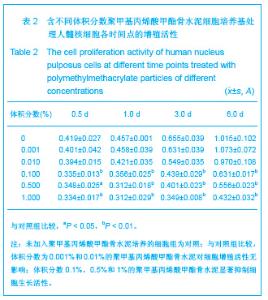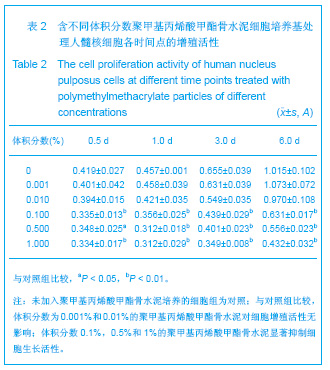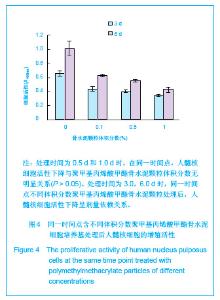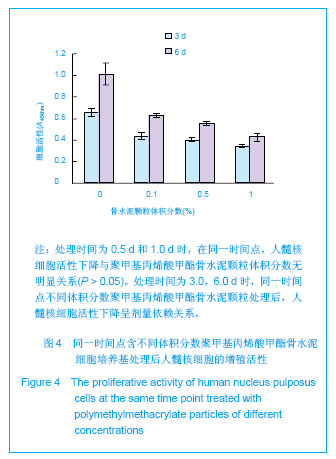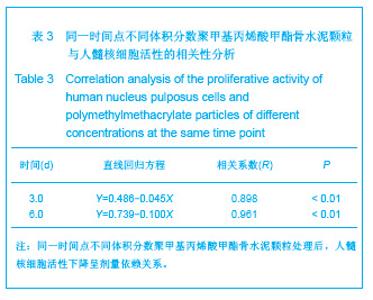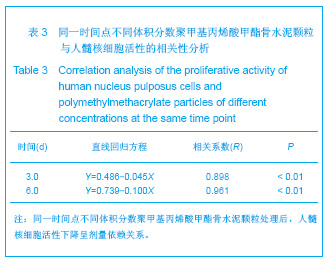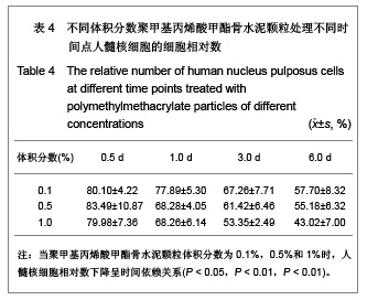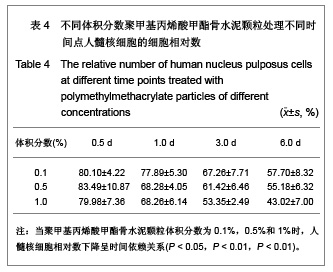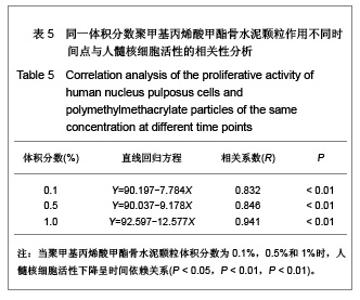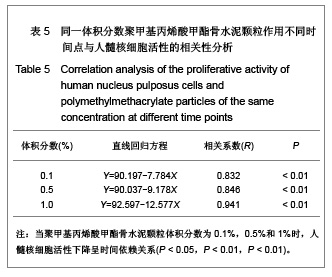Chinese Journal of Tissue Engineering Research ›› 2013, Vol. 17 ›› Issue (12): 2108-2115.doi: 10.3969/j.issn.2095-4344.2013.12.003
Previous Articles Next Articles
Bone cement particles are important to the proliferative capacity of human nucleus pulposus cells
Mao Hai-qing, Geng De-chun, Zhu Xue-song, Zou Jun, Yang Hui-lin
- Department of Orthopedic Surgery, the First Affiliated Hospital of Soochow University, Suzhou 215006, Jiangsu Province, China
-
Received:2013-02-06Revised:2013-02-22Online:2013-03-19Published:2013-03-19 -
Contact:Yang Hui-lin, Professor, Doctoral supervisor, Department of Orthopedic Surgery, the First Affiliated Hospital of Soochow University, Suzhou 215006, Jiangsu Province, China Suzhouspine@163.com -
About author:Mao Hai-qing☆, Doctor, Associate chief physician, Department of Orthopedic Surgery, the First Affiliated Hospital of Soochow University, Suzhou 215006, Jiangsu Province, China maohq@suda.edu.cn
CLC Number:
Cite this article
Mao Hai-qing, Geng De-chun, Zhu Xue-song, Zou Jun, Yang Hui-lin. Bone cement particles are important to the proliferative capacity of human nucleus pulposus cells[J]. Chinese Journal of Tissue Engineering Research, 2013, 17(12): 2108-2115.
share this article
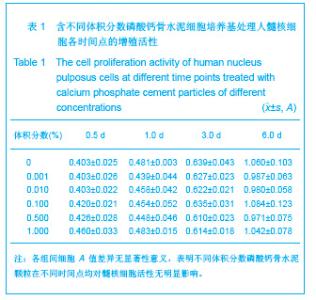
2.3 磷酸钙骨水泥颗粒对人髓核细胞活性的影响 不同体积分数磷酸钙骨水泥颗粒处理人髓核细胞后,在0.5,1.0,3.0,6.0 d检测细胞活性,见表1,统计分析结果显示,不同体积分数磷酸钙骨水泥颗粒在不同时间点均未对髓核细胞活性产生明显影响。 2.4 聚甲基丙烯酸甲酯骨水泥颗粒对人髓核细胞活性的影响 含不同体积分数聚甲基丙烯酸甲酯骨水泥细胞培养基处理人髓核细胞,在0.5,1.0,3.0,6.0 d检测细胞活性,见表2,结果显示聚甲基丙烯酸甲酯骨水泥颗粒体积分数为0.001%和0.01%时对细胞活性影响小,与对照组比较差异无显著性意义(P > 0.05);当其体积分数为0.1%,0.5%和1%时,与未经聚甲基丙烯酸甲酯骨水泥处理组的细胞相比,显著抑制细胞生长活性。"
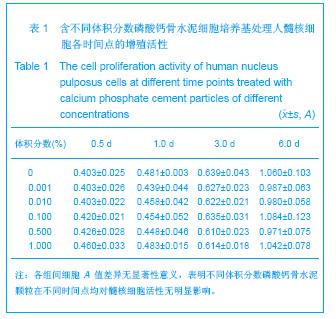
| [1] Hulme PA, Krebs J,Ferguson SJ,et al.Vertebroplasty and kyphoplasty: a systematic review of 69 clinical studies. Spine (Phila Pa 1976).2006;31(17): 1983-2001.[2] Lee MJ, Dumonski M, Cahill P, et al.Percutaneous treatment of vertebral compression fractures: a meta-analysis of complications. Spine (Phila Pa 1976).2009;34(11): 1228-1232.[3] Gray DT, Hollingworth W,Onwudiwe N, et al.Costs and state-specific rates of thoracic and lumbar vertebroplasty, 2001-2005.Spine (Phila Pa 1976).2008;33(17): 1905-1912.[4] McKiernan F,Faciszewski T,Jensen R.Quality of life following vertebroplasty.J Bone Joint Surg Am.2004;86-A(12): 2600-2606.[5] Yeom JS, Kim WJ,Choy WS,et al.Leakage of cement in percutaneous transpedicular vertebroplasty for painful osteoporotic compression fractures. J Bone Joint Surg Br. 2003;85(1): 83-89.[6] Schmidt R, Cakir B, Mattes T,et al.Cement leakage during vertebroplasty: an underestimated problem? Eur Spine J. 2005;14(5): 466-473.[7] Lin EP, Ekholm S, Hiwatashi A, et al.Vertebroplasty: cement leakage into the disc increases the risk of new fracture of adjacent vertebral body. AJNR Am J Neuroradiol.2004;25(2): 175-180.[8] Ahn Y, Lee JH, Lee HY, et al.Predictive factors for subsequent vertebral fracture after percutaneous vertebroplasty. J Neurosurg Spine.2008;9(2): 129-136.[9] Zhao H,Ni CF,Chen L,et al.Zhonghua Fangshexue Zazhi. 2007;41(12): 1405-1408. 赵辉, 倪才方,陈珑,等.骨水泥椎间盘渗漏后组织学和细胞凋亡的实验研究[J]. 中华放射学杂志, 2007,41(12): 1405-1408.[10] Zhao H,Ni CF,Chen L,et al.Zhonghua Chuangshang Zazhi. 2007;23(10): 751-755. 赵辉, 倪才方,陈珑,等.犬椎体成形术中聚甲基丙烯酸甲醋渗漏对椎间盘的影响[J]. 中华创伤杂志,2007,23(10): 751-755.[11] O' Connell GD, Vresilovic EJ, Elliott DM.Comparison of animals used in disc research to human lumbar disc geometry. Spine (Phila Pa 1976).2007;32(3): 328-333.[12] Elliott DM,Yerramalli CS,Beckstein JC,et al.The effect of relative needle diameter in puncture and sham injection animal models of degeneration. Spine (Phila Pa 1976). 2008; 33(6): 588-596.[13] Kobayashi H,Fujishiro T,Belkoff SM,et al.Long-term evaluation of a calcium phosphate bone cement with carboxymethyl cellulose in a vertebral defect model. J Biomed Mater Res A.2009;88(4): 880-888.[14] Johnell O,Kanis JA.An estimate of the worldwide prevalence and disability associated with osteoporotic fractures. Osteoporos Int. 2006;17(12): 1726-1733.[15] Ling X,Cummings SR,Mingwei Q,et al.Vertebral fractures in Beijing, China: the Beijing Osteoporosis Project. J Bone Miner Res.2000;15(10): 2019-2025.[16] Ettinger B,Black DM,Nevitt MC,et al.Contribution of vertebral deformities to chronic back pain and disability. The Study of Osteoporotic Fractures Research Group. J Bone Miner Res. 1992;7(4): 449-456.[17] Silverman SL,Minshall ME,Shen W,et al.The relationship of health-related quality of life to prevalent and incident vertebral fractures in postmenopausal women with osteoporosis: results from the Multiple Outcomes of Raloxifene Evaluation Study. Arthritis Rheum.2001;44(11): 2611-2619.[18] Lindsay R,Silverman SL,Cooper C,et al.Risk of new vertebral fracture in the year following a fracture. JAMA.2001;285(3): 320-323.[19] Klotzbuecher CM,Ross PD,Landsman PB,et al.Patients with prior fractures have an increased risk of future fractures: a summary of the literature and statistical synthesis. J Bone Miner Res.2000;15(4): 721-739.[20] Hasserius R,Karlsson MK,Jónsson B,et al.Long-term morbidity and mortality after a clinically diagnosed vertebral fracture in the elderly--a 12- and 22-year follow-up of 257 patients. Calcif Tissue Int.2005;76(4): 235-242.[21] Kado DM,Browner WS,Palermo L,et al.Vertebral fractures and mortality in older women: a prospective study. Study of Osteoporotic Fractures Research Group. Arch Intern Med. 1999;159(11): 1215-1220.[22] Garfin SR,Yuan HA,Reiley MA.New technologies in spine: kyphoplasty and vertebroplasty for the treatment of painful osteoporotic compression fractures. Spine (Phila Pa 1976). 2001;26(14): 1511-1515.[23] Lieberman IH,Dudeney S,Reinhardt MK,et al.Initial outcome and efficacy of "kyphoplasty" in the treatment of painful osteoporotic vertebral compression fractures. Spine (Phila Pa 1976).2001;26(14):1631-1638.[24] Phillips FM,Todd Wetzel F,Lieberman I,et al.An in vivo comparison of the potential for extravertebral cement leak after vertebroplasty and kyphoplasty. Spine (Phila Pa 1976). 2002;27(19): 2173-2178; discussion 2178-2179.[25] Zampini JM,White AP,McGuire KJ.Comparison of 5766 vertebral compression fractures treated with or without kyphoplasty. Clin Orthop Relat Res.2010;468(7): 1773-1780.[26] Klazen CA,Lohle PN,de Vries J,et al.Vertebroplasty versus conservative treatment in acute osteoporotic vertebral compression fractures (Vertos II): an open-label randomised trial. Lancet. 2010;376(9746):1085-1092.[27] Mirovsky Y,Anekstein Y,Shalmon E,et al.Intradiscal cement leak following percutaneous vertebroplasty. Spine (Phila Pa 1976). 2006;31(10): 1120-1124.[28] Komemushi A,Tanigawa N,Kariya S,et al.Percutaneous vertebroplasty for osteoporotic compression fracture: multivariate study of predictors of new vertebral body fracture. Cardiovasc Intervent Radiol.2006;29(4): 580-585.[29] Syed MI, Patel NA, Jan S,et al.Intradiskal extravasation with low-volume cement filling in percutaneous vertebroplasty. AJNR Am J Neuroradiol.2005; 26(9): 2397-2401.[30] Pitton MB,Herber S,Bletz C,et al.CT-guided vertebroplasty in osteoprotic vertebral fractures: incidence of secondary fractures and impact of intradiscal cement leakages during follow-up.Eur Radiol.2008;18(1): 43-50.[31] Kim SH,Kang HS,Choi JA,et al.Analysis of adjacent fracture after percutaneous vertebroplasty: does intradiscal cement leakage really increase the risk of adjacent vertebral fracture? Skeletal Radiol.2011;40(12):1537-1542.[32] Verlaan JJ,Oner FC,Verbout AJ,et al.Temperature elevation after vertebroplasty with polymethyl-methacrylate in the goat spine. J Biomed Mater Res B Appl Biomater.2003;67(1): 581-585.[33] Belkoff SM, Molloy S .Temperature measurement during polymerization of polymethylmethacrylate cement used for vertebroplasty. Spine (Phila Pa 1976).2003;28(14): 1555-1559.[34] Lai PL,Tai CL,Chen LH,et al.Cement leakage causes potential thermal injury in vertebroplasty. BMC Musculoskelet Disord. 2011;12: 116.[35] Neidlinger-Wilke C,Würtz K,Urban JP,et al.Regulation of gene expression in intervertebral disc cells by low and high hydrostatic pressure. Eur Spine J.2006;15 Suppl 3: p. S372-378.[36] Setton LA,Chen J.Mechanobiology of the intervertebral disc and relevance to disc degeneration. J Bone Joint Surg Am. 2006;88 Suppl 2: 52-57.[37] Baroud G, Heini P, Nemes J,et al.Biomechanical explanation of adjacent fractures following vertebroplasty. Radiology.2003; 229(2): 606-607; author reply 607-608.[38] Gruber HE,Hanley EN Jr.Human disc cells in monolayer vs 3D culture: cell shape, division and matrix formation. BMC Musculoskelet Disord.2000;1: 1.[39] Preradovic A,Kleinpeter G,Feichtinger H,et al.Quantitation of collagen I, collagen II and aggrecan mRNA and expression of the corresponding proteins in human nucleus pulposus cells in monolayer cultures. Cell Tissue Res.2005; 321(3): 459-464. |
| [1] | Liu Zhichao, Zhang Fan, Sun Qi, Kang Xiaole, Yuan Qiaomei, Liu Genzhe, Chen Jiang. Morphology and activity of human nucleus pulposus cells under different hydrostatic pressures [J]. Chinese Journal of Tissue Engineering Research, 2021, 25(8): 1172-1176. |
| [2] | Li Cai, Zhao Ting, Tan Ge, Zheng Yulin, Zhang Ruonan, Wu Yan, Tang Junming. Platelet-derived growth factor-BB promotes proliferation, differentiation and migration of skeletal muscle myoblast [J]. Chinese Journal of Tissue Engineering Research, 2021, 25(7): 1050-1055. |
| [3] | Liu Cong, Liu Su. Molecular mechanism of miR-17-5p regulation of hypoxia inducible factor-1α mediated adipocyte differentiation and angiogenesis [J]. Chinese Journal of Tissue Engineering Research, 2021, 25(7): 1069-1074. |
| [4] | Ma Zetao, Zeng Hui, Wang Deli, Weng Jian, Feng Song. MicroRNA-138-5p regulates chondrocyte proliferation and autophagy [J]. Chinese Journal of Tissue Engineering Research, 2021, 25(5): 674-678. |
| [5] | Wang Yujiao, Liu Dan, Sun Song, Sun Yong. Biphasic calcium phosphate loaded with advanced platelet rich fibrin can promote the activity of rabbit bone marrow mesenchymal stem cells [J]. Chinese Journal of Tissue Engineering Research, 2021, 25(4): 504-509. |
| [6] | Zhou Jihui, Yao Meng, Wang Yansong, Li Xinzhi, Zhou You, Huang Wei, Chen Wenyao. Influence of novel nanoscaffolds on biological behaviors of neural stem cells and the related gene expression [J]. Chinese Journal of Tissue Engineering Research, 2021, 25(4): 532-536. |
| [7] | Li Li, Ma Li. Immobilization of lactase on magnetic chitosan microspheres and its effect on enzymatic properties [J]. Chinese Journal of Tissue Engineering Research, 2021, 25(4): 576-581. |
| [8] | Zhou Wu, Wang Binping, Wang Yawen, Cheng Yanan, Huang Xieshan. Transforming growth factor beta combined with bone morphogenetic protein-2 induces the proliferation and differentiation of mouse MC3T3-E1 cells [J]. Chinese Journal of Tissue Engineering Research, 2021, 25(23): 3630-3635. |
| [9] | Zhou Anqi, Tang Yufei, Wu Bingfeng, Xiang Lin. Designing of periosteum tissue engineering: combination of generality and individuality [J]. Chinese Journal of Tissue Engineering Research, 2021, 25(22): 3551-3557. |
| [10] | Lang Limin, He Sheng, Jiang Zengyu, Hu Yiyi, Zhang Zhixing, Liang Minqian. Application progress of conductive composite materials in the field of tissue engineering treatment of myocardial infarction [J]. Chinese Journal of Tissue Engineering Research, 2021, 25(22): 3584-3590. |
| [11] | Yu Chengshuai, Du Gang, Pang Shenning, Lao Shan. Chemerin, a pro-inflammatory adipokine, regulates chondrocyte proliferation and metabolism by increasing production of nitric oxide [J]. Chinese Journal of Tissue Engineering Research, 2021, 25(2): 258-263. |
| [12] | Fu Yuanfei, He Shenghua, Lai Juyi, Sun Zhitao, Feng Hualong, Lan Zhiming . Pheretima extract ameliorates nucleus pulposus cell degeneration in the intervertebral disc by inhibiting nuclear factor-kappa B pathway [J]. Chinese Journal of Tissue Engineering Research, 2021, 25(2): 264-268. |
| [13] | Dai Yaling, Chen Lewen, He Xiaojun, Lin Huawei, Jia Weiwei, Chen Lidian, Tao Jing, Liu Weilin. Construction of miR-146b overexpression lentiviral vector and the effect on the proliferation of hippocampal neural stem cells [J]. Chinese Journal of Tissue Engineering Research, 2021, 25(19): 3024-3030. |
| [14] | Zhang Kai, Zhang Xiaobo, Shi Jintao, Wang Keping, Zhou Haiyu. Mesenchymal stem cells for treatment of intervertebral disc degeneration: a bibliometric and visualization analysis based on Web of Science database [J]. Chinese Journal of Tissue Engineering Research, 2021, 25(19): 3031-3038. |
| [15] | Ailimaierdan·Ainiwaer, Wang Ling, Gu Li, Dilidaer•Taxifulati, Wang Shan, Yin Hongbin. Effect of transforming growth factor-beta3 on the proliferation and osteogenic capability of osteoblasts [J]. Chinese Journal of Tissue Engineering Research, 2021, 25(17): 2664-2669. |
| Viewed | ||||||
|
Full text |
|
|||||
|
Abstract |
|
|||||
